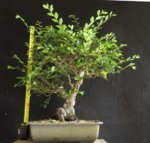@Ingvill ,
our elms were purchased in 1993 and 1996, they were Mallsai from Soho, London, Mr. Mings.
We also have 1980 from the US ---- catlin
There were 5 or 6 different types. The source was Red Sun Bonsai outside of of London.
We visited the nursery and found them to be outside in November/ December with a
translucent plastic covering over the lot of trees. Possibly to prevent Frost damage ?
From there we found out that they were from Holland and had come from South China [ zone 9 ]
and were shipped in the containers x months on sea.
The soil was whatever they were growing in the open fields in China.
More or less a clay type with stones.
We cannot import conifers and other trees must be barerooted. So we washed them and then
treated them for nematodes and the English Plant Quarantine folk inspected them for the
cost of 20 pounds.
Of the types, one proved to be a monster at growing.
We use root cuttings to propagate and one cutting in a 1/3 US 55 gallon black plastic barrel,
with a coarse soil mix shot up to 8 cm in 6 months.
So I would advise do some root cuttings when the weather is with you.
Anyhow, they sleep from Christmas until February 15th and are all alive today.
I mentioned Zelkova Sinica since that is how they were listed in the 80's [ and in Italy
as well ] to be imported.
The mallsai are mostly like to be Southern Chinese Elms, so you would have to test
the root cuttings by growing them outdoors for the year.
Our new root cuttings are just about to put out shoots.
Roots are often more interesting than the top of the tree cuttings.
They grow easily indoors, but they need to be rested, or after 4 years, like maples,
without a winter's rest may just fade or die suddenly.
Good Day
Anthony
Southern Chiinese elm ------- the 6 month special


